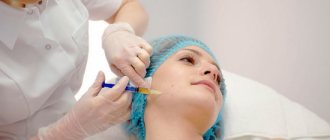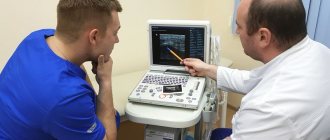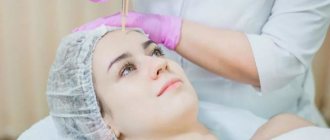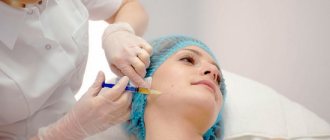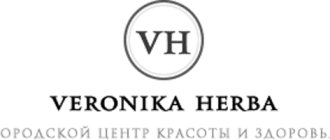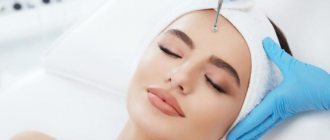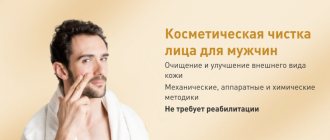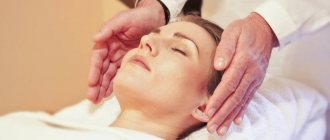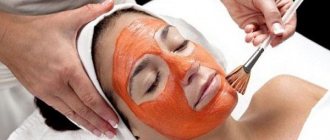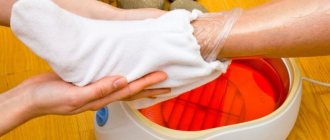Plasma therapy is the injection of the patient’s own purified plasma under the skin. Several injections are made throughout the treatment area so that the distribution of plasma in the problem area is as uniform as possible. The procedure has a very beneficial effect on the skin, the main effect is stimulation of skin fibroblasts and the production of elastin and collagen. Visually, the skin tightens after a course of injections, becomes glowing and youthful in appearance.
Plasma, processed in a special way, contains a large number of platelets, which greatly activate metabolic processes in the place where they are injected. The complex effect of plasma therapy is the launch of self-rejuvenation from the inside. For this, the patient’s body’s own liquid, the “native” plasma, is used, so no rejection or allergy reaction occurs at the injection site.
Quite often, during plasma therapy, a course of injections of hyaluronic acid is simultaneously carried out, which restores the youthful volume of the skin, normalizes its moisture and stimulates the production of collagen and elastin. In addition, microneedle injections have a stimulating effect on the process of tissue regeneration.
Plasma therapy can be performed not only on the face, but also on many other parts of the body (hips, buttocks, chest, arms, etc.). It allows you to tighten weakened and sagging skin and smooth out cellulite. Sometimes plasma injections are used to relieve excessive dryness of the genitals.
This method of rejuvenation not only gives a well-defined cosmetic effect, but also does not cause severe trauma and does not require long and complex rehabilitation. Patients can very quickly return to a normal lifestyle and usual activities.
Effect of plasma therapy
During experiments, scientists discovered that platelet autoplasma has the effect of an “elixir of youth.” When introduced into the skin, it stimulates the production of elastin and collagen, normalizes the supply of oxygen to tissues, makes the skin more moisture-filled, etc. All these effects do not remain visually invisible - the skin tightens, becomes elastic and moisturized, wrinkles are smoothed out.
Plasma therapy increases the local immunity of the skin, which has a beneficial effect on pustular and inflammatory diseases. In addition, there is a powerful stimulation of the regeneration of damaged tissue, so plasma therapy is sometimes used to accelerate the healing of skin damage.
Plasma therapy is used not only on the skin, but also on the mucous membranes. A very rapid tissue response is observed on the mucous membranes. But even in the skin, the very first effect (tissue response) is observed within two hours after injection. However, it takes time for collagen and elastin to grow, so the main effect appears after 1-2 weeks and then increases for some time. The effect of plasma therapy lasts from six months to a year, and sometimes more.
The greatest effect is observed in tissues directly in contact with the injection site (injection point). An important rule of the procedure is to completely “envelop” the entire area of tissue to be treated with plasma therapy. There should be no gaps.
Plasmolifting in Vita SPA Saratov
Beauty and cosmetology salon Vita SPA / Problem solving / Face, neck, décolleté / Acne, acne, problem skin /
What is plasma lifting
A new therapeutic and rejuvenating technique is a unique development of Russian scientists!
Plasmolifting is a cosmetic procedure aimed at rejuvenating the skin by stimulating the natural processes of elastin, collagen and hyaluronic acid production.
The essence of the technique is to introduce the patient’s own plasma into the skin through shallow injections. Plasmolifting is a revolutionary discovery in medicine for rejuvenation, as well as the correction of pathological and age-related changes in the skin using injections of platelet-rich human blood plasma. Invented and first used in 2003 by Russian scientists R. R. Akhmerov and R. F. Zarudiy, the method is currently successfully used by cosmetology clinics around the world. And now it is available at the VitaSPA Center for Aesthetic Medicine and Rehabilitation!
This technique is absolutely safe, since platelet-rich plasma is made from the patient’s own blood without the addition of foreign chemicals and does not come into contact with the environment during the procedure.
Benefits of plasma lifting
Using the plasma lifting procedure in cosmetology, the following effects of restoring natural beauty and health are achieved:
- the skin is cleared of pigment spots,
- complexion improves,
- mimic wrinkles are eliminated,
- aging processes are slowed down,
- the skin is deeply moisturized and nourished,
- skin turgor improves, facial oval tightens,
- acne and post-acne disappear,
- scars become less noticeable,
- skin rehabilitation occurs after excessive insolation (sun exposure),
- skin restoration processes are accelerated after laser or chemical peeling.
Contraindications
- Viral hepatitis B and C
- Pregnancy and breastfeeding period
- Blood diseases (anemia)
- Diabetes
- Oncological and psychological diseases
- Inflammatory processes of the skin (viral or bacterial)
- Autoimmune diseases
- Hemoglobin and fibrinogen levels are below normal
- Acute diseases or exacerbation of chronic processes
How does the plasma lifting procedure work?
Preparation for plasma lifting occurs a day or two before the procedure. These days, it is advisable to exclude fatty and spicy foods from food, as well as alcohol. On the day of the procedure, it is advisable to have your last meal 3-4 hours before. These measures are necessary to ensure that the plasma that will be injected into the patient’s facial skin is as purified as possible.
Before starting the procedure, the specialist cleanses the patient’s face with a cosmetic product, after which he applies an anesthetic cream. Next, he collects venous blood from the patient, and the tube with blood is placed in a centrifuge. As a result of processing, the blood is separated and the plasma is separated. The resulting plasma is injected into the patient's facial skin using shallow injections.
Result
As is known, the aging process is due to the fact that skin cells fall into “depression” with age: metabolism slows down, decay and waste products are not completely eliminated, there is not enough oxygen, etc. Platelet-rich plasma (PRP), which is injected into problematic zones, triggers natural mechanisms of regeneration and renewal of skin cells. The cell begins to produce hyaluronic acid and its own collagen in the same volume as it was several years ago. In addition, the plasma lifting course increases local skin immunity, normalizes blood circulation and metabolism, relieves inflammation and suppresses the growth of pathogenic bacteria.
As a result, the skin not only looks young, it functions as young and healthy - this is the fundamental difference between plasma lifting and all existing cosmetological rejuvenation techniques!
The visible rejuvenation effect occurs after the first procedure and lasts up to two years : it all depends on the initial quality of the skin, age and general health of the person. A cosmetologist recommends taking a course at the first signs of skin aging. The sooner plasma lifting is used, the brighter and longer the result will be!
Facial skin care after the procedure
- On the day of plasma lifting, do not use cosmetics or foundation
- It is advisable not to apply decorative cosmetics for 1-2 days
- 2-3 days after plasma lifting you cannot visit the bathhouse or sauna.
- Do not perform traumatic cosmetic procedures (for example, peeling or facial cleansing) until the injection sites have healed
Cost of plasma lifting
Face - 5000 rubles;
Face, neck and décolleté - 8,000 rubles;
Hairy part of the head - 3000 rubles.
Feedback from our clients about plasma lifting
Katya Varenkova
had a facial plasmolifting procedure done at the VitaSPA salon and was very pleased. The skin tightened and became elastic. And it was very pleasant to listen to compliments about rejuvenation)
Lyudmila Rozman
I am 48 years old, I feel like I am 30. And I wanted my face to look 30 too)) I trusted the VitaSPA professionals, whom I had heard about from friends and underwent the plasma lifting procedure. I must say that the result surprised me - of course, I didn’t lose 18 years, but I did look 7-10 years younger. My husband was pleased!)
Lilya Kurbatova
I went for plasma lifting to solve the problem of acne and its consequences. The procedure itself is very interesting - injections with my own blood. At first I doubted the price, but after a course of procedures and the results I received, I was very pleased. In fact, the skin's immunity has increased - it is fresher, smoother, blemishes have gone away and the appearance of new rashes has significantly decreased. I went to Serdyukova, an excellent specialist!
The procedure is carried out:
Ivanova Yanina
Chief physician, cosmetologist
Sign up
Tolokova Svetlana
Cosmetologist, dermatovenerologist, contour plastic specialist
Sign up
Serdyukova Nadezhda
Cosmetologist, dermatovenerologist, physiotherapist
Make an appointment
The difference between plasma therapy and PRP therapy
Plasma therapy and PRP therapy are procedures with the same principle of action, but slightly different in the material used. Their effect is also somewhat different. The main difference is the density of platelet concentration per microliter. processed plasma. For plasma therapy, plasma containing 200 - 4000 thousand platelets per μl is prepared, and for PRP therapy, plasma containing 1,000,000 platelets per μl is used.
Well, there are slight differences in the frequency of injections in the course - with plasma therapy they are given more often and the number per course is greater. The average standard course of plasma therapy includes 4 sessions with a frequency of 7-10 days (to maintain the result, 2 courses are done per year), and the standard average course of PRP therapy includes 3 sessions with a month interval between them (to maintain the result, the course is repeated once a year) .
Advantages of plasma therapy in orthopedics
The new technique has gained popularity due to its special properties:
- no allergic reaction;
- guarantee of sterility of the biomaterial, exclusion of foreign infections;
- the drug acts only at the injection site, without entering the systemic bloodstream;
- recovery occurs 2-3 times faster than with drug treatment;
- minimum complications;
- no side effects.
PRP therapy for joints differs significantly from the effects of non-steroidal, hormonal drugs. Glucocorticoids, which effectively relieve inflammation, have a destructive effect on cartilage and the body as a whole. PRP therapy restores their structure without affecting the internal organs.
Plasma therapy and transplantation
Will the new technique help cancel or postpone the operation? What do doctors say about this?
The operation to implant a prosthesis is far from a harmless procedure. Like any surgical intervention, it requires preparation and long postoperative rehabilitation. The process does not always go without complications and repeated interventions.
In addition, replacing a joint will not always completely solve the problem. Surgeons are usually silent about this
— after replacing one hip joint, due to the difference in load, there is strong pressure on the second joint. As a rule, within a year or two, the patient will need to replace the second joint.
If the disease is not advanced, a course of plasma therapy along with other methods will eliminate the need for surgery. In advanced severe cases, injections will help postpone transplantation for a certain period. Whether a replacement is needed or not in such a situation is decided by the attending physician.
Any joint disease has serious complications, so you should not delay treatment.
Read more about joint treatment in our clinic
For people who have contraindications to surgery, PRP joint therapy provides a chance to reduce symptoms for a long period. The safety of the method has been proven - according to WHO, more than 20 thousand patients are treated every year around the world.
What forms of plasma are used?
The native form is autologous plasma prepared using classical centrifugation technology. It is used most often in cosmetology practice. This plasma restores the water balance in the skin, reduces age-related changes and activates regeneration. This is the most biologically stimulating form of plasma.
Fibrin form of autologous plasma - heated at a temperature of 56C. As a result, fibrinogen irreversibly clots. The resulting fibrin form is a specific mesh matrix on which monocytes, fibroblasts and other cells accumulate, which activate collagen production. Fibroblasts attracted and accumulated on the injected fibrin significantly increase skin turgor and thicken it.
The gel form of autologous plasma is heated in a thermostat for 10 minutes to a temperature of 75-80 C. This plasma is injected into the deep layers of the dermis. It has the strongest effect of strengthening the skin by stimulating the formation of collagen and elastin fibers and best corrects age-related deformational changes. After administration, a lifting effect is observed that increases over several weeks.
The essence of the method
The name PRP is an abbreviation for Platelet rich plasma (blood plasma enriched with platelets). We are talking about a substance with a high platelet content. But where do they get this composition and how do they use it? This will be discussed further below.
Some historical facts
The method is essentially not new. Active searches were conducted back in the 20th century. The first sources on the topic of using platelet-rich plasma to eliminate pathologies of the musculoskeletal system appeared in the 70s of the last century.
More recent articles by American researchers were published in 1997-1998. They talked about the use of the enriched composition in maxillofacial surgery. The new technique quickly moved to Europe. In the 21st century, it is used in almost all areas of medicine, as well as cosmetology.
What is PRP therapy
Treatment of joints with the PRP method is based on the functional properties of human blood platelets. The elements are known as clotting factors. They promote the formation of a blood clot when a blood vessel is damaged. Thanks to them, wounds stop bleeding.
But the main feature is that these blood elements help the regeneration of connective tissue cells. This fact became the reason for their use in the treatment of joint diseases. They stimulate fibroblast cells to actively synthesize collagen and elastogen. These substances are part of the bone and cartilage system, skin, and ligaments.
Enriched blood plasma contains up to 1000–2500×1009/l. platelets. In their usual form they are no more than 180–320×109/l. Venous blood is used for manipulation. Its separation and enrichment is achieved using a centrifuge.
Blood components have different weights and sizes. As a result of centrifugation, the biomaterial in the test tube is stratified. The heavier, red elements settle to the bottom, and the enriched plasma forms the top layer. The result is a concentrated composition.
Blood plasma prepared for the procedure
Growth factors
These blood cells contain bioactive substances - growth factors. They have a protein structure. There are several of them, which explains the multifaceted effect of the medicine.
- insulin-like IGF
– regulates cell growth, migration and development; - platelet PDGF
– ensures cellular regeneration (survival); - transforming TGF
– inhibits tissue necrosis, suppresses inflammation, stimulates collagen production; - endothelial f.
R. blood vessels VEGF – affects vascular permeability, increases blood supply to organs; - epidermal EGF
– triggers self-healing at the cellular level. Stimulates cell division and renewal; - f.r.
fibroblasts FGF – increases the concentration of fibroblasts, accelerates the development of blood vessels.
The destruction of cartilage is difficult to stop. They do not contain blood vessels through which nutrients are delivered. Everything you need comes from the synovial fluid that fills the joint cavity. Therefore, administering the medicine directly to the diseased organ is the most effective method of treatment.
How to prepare for the procedure
The first stage is a consultation with a doctor to determine the presence or absence of contraindications to plasma therapy. The doctor will prescribe a series of tests, which include a blood test, a biochemical blood test, and tests for hepatitis and HIV. If it is confirmed that there are no contraindications, then a week before the procedure you should stop peeling the areas to be treated and stop taking all medications (consult your doctor on this topic). Three hours before the session it is not recommended to have a heavy lunch or overeat.
How does the plasma therapy procedure work?
The patient comes into the office and lies down on the couch. The cosmetologist cleanses the skin of the face and applies a special anesthetic gel to numb the injections. Then, the doctor takes blood from the patient’s vein (8-36 ml) and immediately places the tube with it in a centrifuge. After 10-15 minutes of blood being in the centrifuge, plasma is separated. During this time, the anesthetic gel has time to take effect. The doctor immediately draws the plasma into a syringe with a thin needle and begins to inject evenly throughout the area to be treated. The procedure takes 45-60 minutes. After this, the doctor treats the skin with a disinfectant, soothing and wound-healing composition.
Rehabilitation
Mild pain and swelling of the treated tissues, which disappear completely after three days, are considered normal manifestations during the recovery period. To prevent complications, you need to avoid skin infection and sunburn, irritation from cosmetics or overheating in the bath.
Within two weeks after the session, the skin is completely restored, but since plasma therapy is carried out in courses with an interval of 7-10 days, the entire period between procedures and 14 days after the final session must adhere to some restrictions and rules in caring for damaged skin.
You should not use any cosmetics other than those prescribed by your doctor. It is forbidden to touch or scratch your face, as this will cause infection in the wounds. You should not sunbathe or visit a solarium, and when going outside you should use sunscreen or a wide-brimmed hat. Also, it is prohibited to visit the bathhouse and sauna. It is not recommended to drink alcohol, as it affects blood flow and the rate of skin regeneration. When choosing a sunscreen and regenerating cream, you should definitely consult your doctor.
Compatibility with other therapeutic procedures
In our clinic, plasma therapy is combined with other non-surgical methods of treating the musculoskeletal system:
- acupuncture;
- manual therapy;
- different types of massage – acupressure, classic, Thai, etc.;
- hirudotherapy - treatment using leeches;
- exposure to vacuum cans;
- kinesiotherapy under the influence of loads;
- kinesio taping (using cotton tapes);
- blockades with painkillers and anti-inflammatory drugs.
A comprehensive course of joint treatment, using prp therapy and other methods, gives the fastest and most lasting effect.
Themes
Joints, Treatment methods Date of publication: 12/09/2019 Date of update: 06/08/2020
Reader rating
Rating: 4.5 / 5 (4)
Expected effect of plasma therapy
- The skin becomes elastic and fresh.
- Small wrinkles disappear.
- The complexion becomes more even.
- Pigment spots from tanning fade.
- The oval of the face is tightened.
- Scars on the skin are smoothed out a little.
- Sebum secretion is stabilized.
- Skin regeneration accelerates after peeling.
Multiple treatments are usually required to achieve the desired level of change. Their number is determined by the doctor depending on how the patient’s tissues respond to plasma therapy. For some people, the results are clearly visible within a couple of days, while for others, only after a couple of months. The degree of effect largely depends on age; at 30 years of age, the changes after plasma therapy are much more significant than at 60, although the quality of the skin improves in any case.
Scars and cicatrices are smoothed out due to the activation of the growth of new young skin structures. The combination of peeling followed by plasma therapy is especially effective for removing scars and post-acne. In this case, peeling cuts off old uneven structures, and plasma therapy stimulates active replacement with new young skin cells.
In any case, remember that the effect of plasma therapy increases gradually as collagen and elastin fibers are formed. They cannot grow in the first few days after the procedure. Therefore, the progressive development of improvements in skin turgor is clearly expressed.
